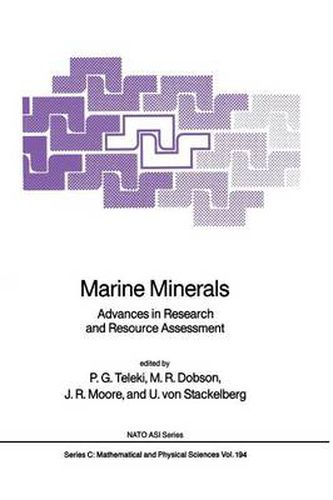Readings Newsletter
Become a Readings Member to make your shopping experience even easier.
Sign in or sign up for free!
You’re not far away from qualifying for FREE standard shipping within Australia
You’ve qualified for FREE standard shipping within Australia
The cart is loading…






This title is printed to order. This book may have been self-published. If so, we cannot guarantee the quality of the content. In the main most books will have gone through the editing process however some may not. We therefore suggest that you be aware of this before ordering this book. If in doubt check either the author or publisher’s details as we are unable to accept any returns unless they are faulty. Please contact us if you have any questions.
Discoveries of new types of marine mineral occurrences during the last decade, and specifically the massive sulfide deposits at spreading ridges on the ocean floor, have significantly advanced geologic concepts about the origin of ore deposits in a very short period of time. These discoveries also renewed interest in all marine mineral occurrences including the well-known manganese nodules, and led to more wide-ranging and thorough examination of cobalt-rich manganese crusts, expanded mapping of phosphorites of continental shelves, and the initiation of several new surveys for placer minerals in shallow waters. The result of these activities is already noticeable in an increasingly broader variety of minerals being found on and below the ocean floor. This upsurge of scientific interest and research in marine minerals provided the impetus to organize an Advanced Research Workshop under auspices of the NATO Science Council and its Special Program Panel on Marine Sciences. The workshop was held in the United Kingdom at Gregynog Hall of the University of Wales, June 10-16, 1985, under the theme Marine Minerals–Resource Assessment Strategies.
The timing of this workshop was propitious in many ways. First, marine surveys and expeditions to chart the mineral resources of the world’s oceans had increased in number in recent years, involving a growing number of nations interested in obtaining firsthand information.
$9.00 standard shipping within Australia
FREE standard shipping within Australia for orders over $100.00
Express & International shipping calculated at checkout
This title is printed to order. This book may have been self-published. If so, we cannot guarantee the quality of the content. In the main most books will have gone through the editing process however some may not. We therefore suggest that you be aware of this before ordering this book. If in doubt check either the author or publisher’s details as we are unable to accept any returns unless they are faulty. Please contact us if you have any questions.
Discoveries of new types of marine mineral occurrences during the last decade, and specifically the massive sulfide deposits at spreading ridges on the ocean floor, have significantly advanced geologic concepts about the origin of ore deposits in a very short period of time. These discoveries also renewed interest in all marine mineral occurrences including the well-known manganese nodules, and led to more wide-ranging and thorough examination of cobalt-rich manganese crusts, expanded mapping of phosphorites of continental shelves, and the initiation of several new surveys for placer minerals in shallow waters. The result of these activities is already noticeable in an increasingly broader variety of minerals being found on and below the ocean floor. This upsurge of scientific interest and research in marine minerals provided the impetus to organize an Advanced Research Workshop under auspices of the NATO Science Council and its Special Program Panel on Marine Sciences. The workshop was held in the United Kingdom at Gregynog Hall of the University of Wales, June 10-16, 1985, under the theme Marine Minerals–Resource Assessment Strategies.
The timing of this workshop was propitious in many ways. First, marine surveys and expeditions to chart the mineral resources of the world’s oceans had increased in number in recent years, involving a growing number of nations interested in obtaining firsthand information.